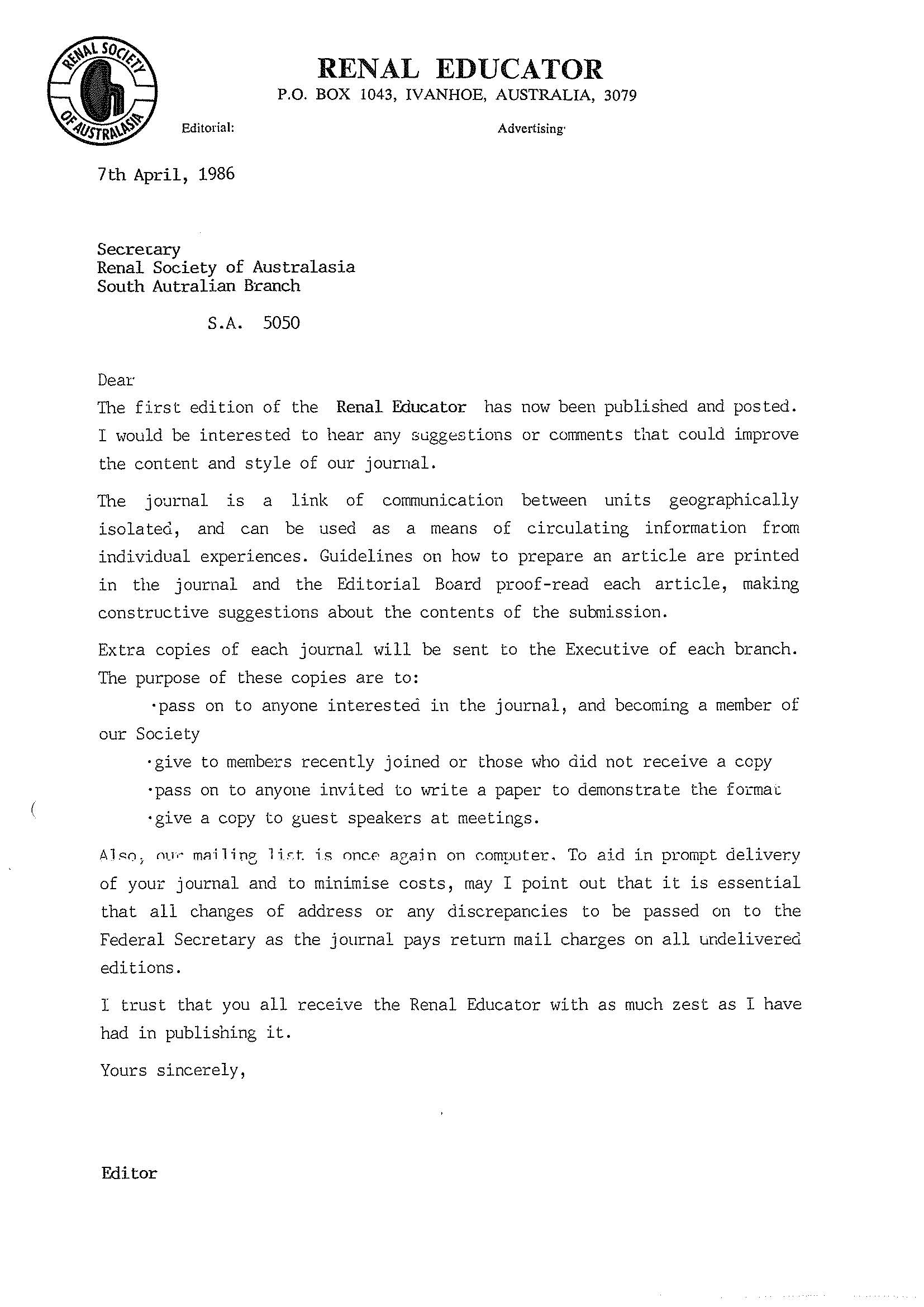Volume 15 Number 3
How far we have come, both as a society and as an information sharer
Melissa Arnold-Chamney
For referencing Arnold-Chamney M. (2019). How far we have come, both as a society and as an information sharer. RSAJ Journal, 15(3):76-77.
DOI https://doi.org/10.33235/rsaj.15.3.76-77
History can teach us so much about the here and now, and this is true of our Renal Society and the way we provide information to our members. It is now 33 years since the Editor of Renal Educator wrote to members – as shown in the following page – informing them that the first edition had been published and posted. It is 14 years since Paul Bennett introduced the Renal Society of Australasia (RSA) Journal to members in hard copy format. In the intervening years, technological advances have meant that the original purpose of the ‘renal educator’ – as a communication link between geographically isolated units within Australia and as an information source in staff tea rooms – has progressed to a fully online, accessible 24 hours a day journal which is highly valued by not only renal nurses in Australia but also across the world.
In the first RSA Journal issue in 2005 the nurse practitioner role was considered as a means to address increasingly complex patient care needs by providing another health service choice and legitimising advanced nursing practice (Stanley, 2005). At the time this was something new to Australia and yet now it is standard to find nurse practitioners in most clinical areas. 2005 also saw an article aimed at raising awareness for greater facial barrier protection (Bublitz, 2005) and, again, this is something that is not even questioned by health professionals in 2019 – protective clothing must be provided for all staff where there is a high risk of contamination.
Other things have also changed. As at 31 December 2004 there were 7,952 people receiving renal replacement therapy (RRT) in the form of either haemodialysis or peritoneal dialysis (McDonald & Excell, 2005); this has increased to 13,399 people receiving RRT as at 31 December 2018 (McDonald, 2019). This shows the importance of pre-dialysis education and, in 2010, Walker, Abel & Meyer (2010) highlighted the need for more standardised pre-dialysis nursing care in New Zealand. Nursing-led pre-dialysis clinics can lead to patients and their families having a well-rounded education on all aspects of their care. The importance of supportive care was also detailed by Moustakas, Bennett & Tranter in 2015, giving a good insight into this facet of renal care.
What will the future of renal therapy be? Could stem cell-based therapies become the norm as a treatment of kidney disease? Such innovations may resolve the issue of an insufficient number of donor kidneys being available, reduce the likelihood of transplanted organs being rejected, and diminish patient reliance on burdensome dialysis treatment. Exciting developments such as these lead me to ask where the future will lead us as renal nurses and health professionals. One thing I do know is that things change and this is the same with the RSA Journal. I have been honoured to have been the editor in chief of the RSA Journal for the past 4 years and will be handing this over next April to Kathy Hill – my last issue will be March 2020. I will be staying on the editorial board as an associate editor whilst maintaining my academic role exploring new research directions in renal nursing focussing on Indigenous populations. I wish Kathy the very best and wish for the journal a future that continues to educate and encourage renal care to be at the forefront of our thoughts.
I do hope you enjoy reading this issue which contains articles on a variety of topics including an article on cannulation in haemodialysis and a case study which focuses on an Aboriginal patient’s experience with extensive chronic tinea corporis and delayed kidney transplantation wait-listing. A further article considers nurses’ experience of caring for a renal transplant recipient when they are admitted into hospital. The final article is a literature review that focuses on chronic kidney disease patients’ perception of exercise and physical activity.
Wishing all our readership a safe holiday season and a happy 2020. A special thanks to the associate editors Ann and Deidre for their continuing support and the editorial board who have peer reviewed the articles submitted this year. Please do keep submitting articles to the journal so that 2020 can be another great year for the journal as another new phase commences.

Author(s)
Melissa Arnold-Chamney
The University of Adelaide, SA, Australia
Email: melissa.arnold-chamney@adelaide.edu.au
References
Bublitz, L. (2005). Facial protection in renal dialysis units: A literature review. Renal Society of Australia Journal, 1(2), 65–69.
McDonald, S. P., & Excell, L. (2005). The Twenty Eighth report: Australia and New Zealand Dialysis and Transplant Registry. Retrieved from https://www.anzdata.org.au/wp-content/uploads/2016/12/ContentsandSummary-3.pdf
McDonald, S. P. (2019). The Forty Second report: Australia and New Zealand Dialysis and Transplant Registry. Retrieved from https://www.anzdata.org.au/report/anzdata-42nd-annual-report-2019/
Moustakas, J., Bennett, P. & Tranter, S. (2015) The information needs of older people who choose supportive care over dialysis: a case study approach: Moustakas J, Bennett PN, Tranter S. Renal Society of Australia Journal, 11(1), 6–11.
Stanley, M. J. (2005). A nurse practitioner model of care in maintenance dialysis: A personal and professional reflective journey (Part A). Renal Society of Australia Journal, 1(1), 25–32.
Walker, R., Abel, S., & Meyer, A. (2010). The role of the pre-dialysis nurse in New Zealand. Renal Society of Australia Journal, 6(1), 5–10.
